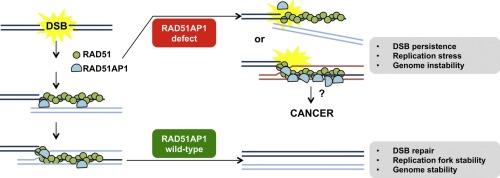Role of RAD51AP1 in homologous recombination DNA repair and carcinogenesis |
| |
| Affiliation: | 1. Department of Environmental and Radiological Health Sciences, Colorado State University, Fort Collins, CO 80523, USA;2. Department of Microbiology, Immunology and Pathology, Colorado State University, Fort Collins, CO 80523, USA;3. Department of Molecular Biophysics and Biochemistry, Yale University School of Medicine, New Haven, CT 06520, USA;1. Massachusetts General Hospital Cancer Center, Harvard Medical School, Charlestown, MA 02129, USA;2. Department of Pathology, Massachusetts General Hospital, Harvard Medical School, Boston, MA 02114, USA;1. Institute of Molecular Cancer Research, University of Zurich, 8057 Zurich, Switzerland;2. Centre de Recherche en Cancérologie de Marseille, CNRS, INSERM, Aix-Marseille Université, Institut Paoli-Calmettes, 13009 Marseille, France;1. Department of Radiation Oncology, Dana-Farber Cancer Institute, Boston, MA 02215, USA;2. Center for DNA Damage and Repair, Dana-Farber Cancer Institute, Boston, MA 02215, USA;3. Department of Pharmacology, University of Washington, Seattle, WA 98195, USA;4. Howard Hughes Medical Institute, Box 357280, Seattle, WA, USA;1. Edward A. Doisy Department of Biochemistry and Molecular Biology, Saint Louis University School of Medicine, St. Louis, MO 63104, USA |
| |
| Abstract: | 
Homologous recombination (HR) serves to repair DNA double-strand breaks and damaged replication forks and is essential for maintaining genome stability and tumor suppression. HR capacity also determines the efficacy of anticancer therapy. Hence, there is an urgent need to better understand all HR proteins and sub-pathways. An emerging protein that is critical for RAD51-mediated HR is RAD51-associated protein 1 (RAD51AP1). Although much has been learned about its biochemical attributes, the precise molecular role of RAD51AP1 in the HR reaction is not yet fully understood. The available literature also suggests that RAD51AP1 expression may be relevant for cancer development and progression. Here, we review the efforts that led to the discovery of RAD51AP1 and elaborate on our current understanding of its biochemical profile and biological function. We also discuss how RAD51AP1 may help to promote cancer development and why it could potentially represent a promising new target for therapeutic intervention. |
| |
| Keywords: | Homologous recombination DNA repair Cancer DNA double-strand breaks Replication Genome stability RAD51AP1 Cancer therapy |
| 本文献已被 ScienceDirect 等数据库收录! |
|

